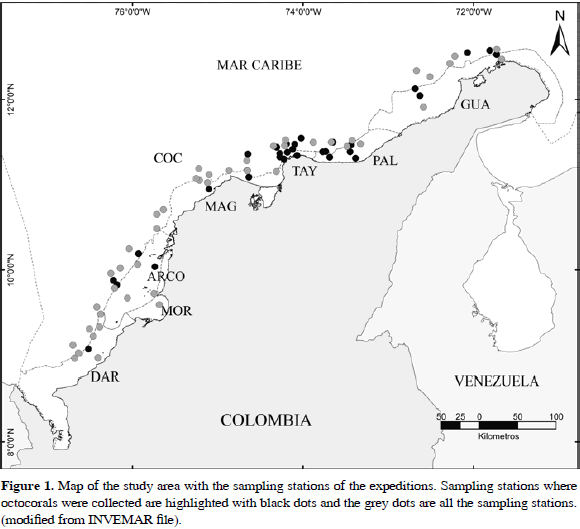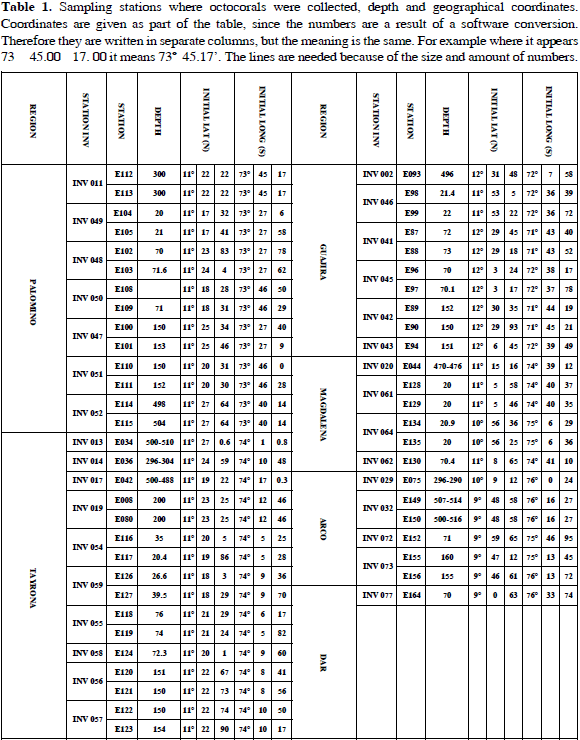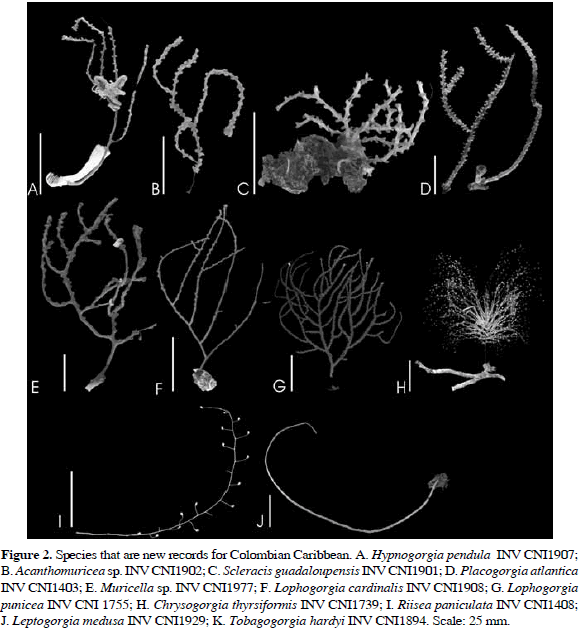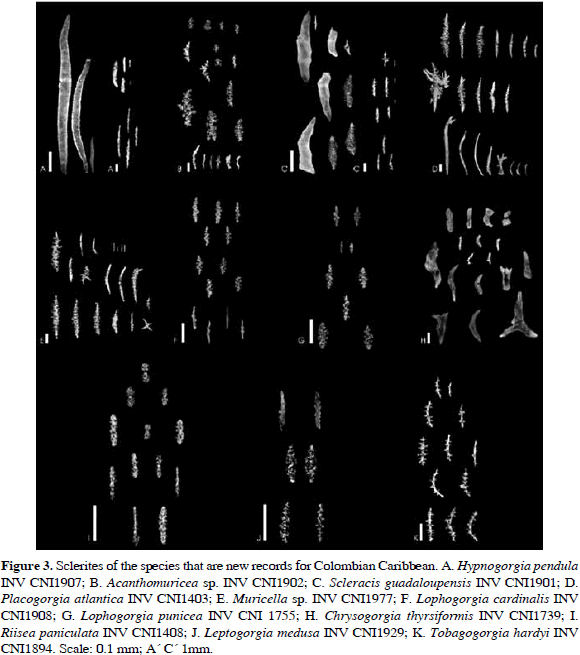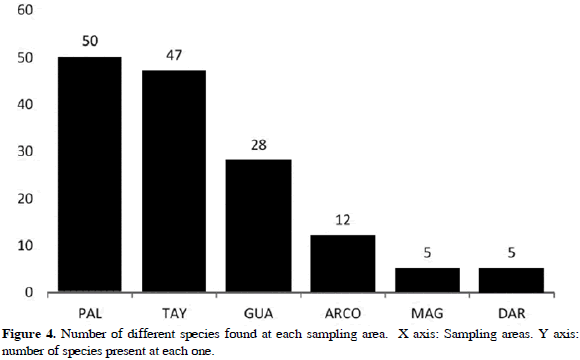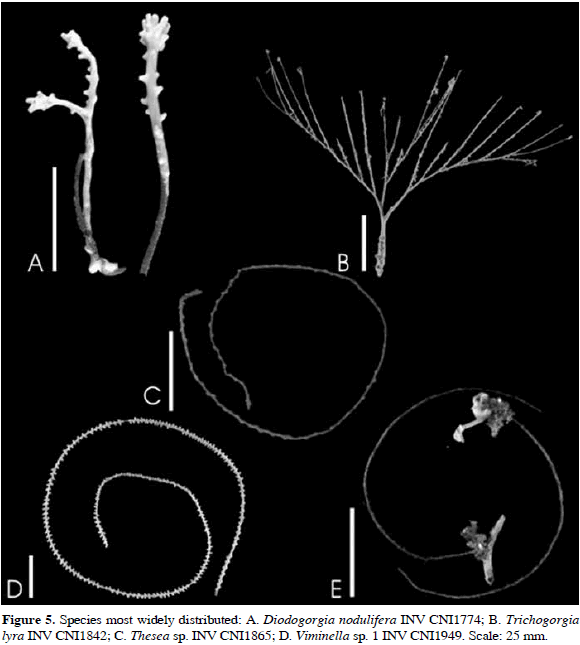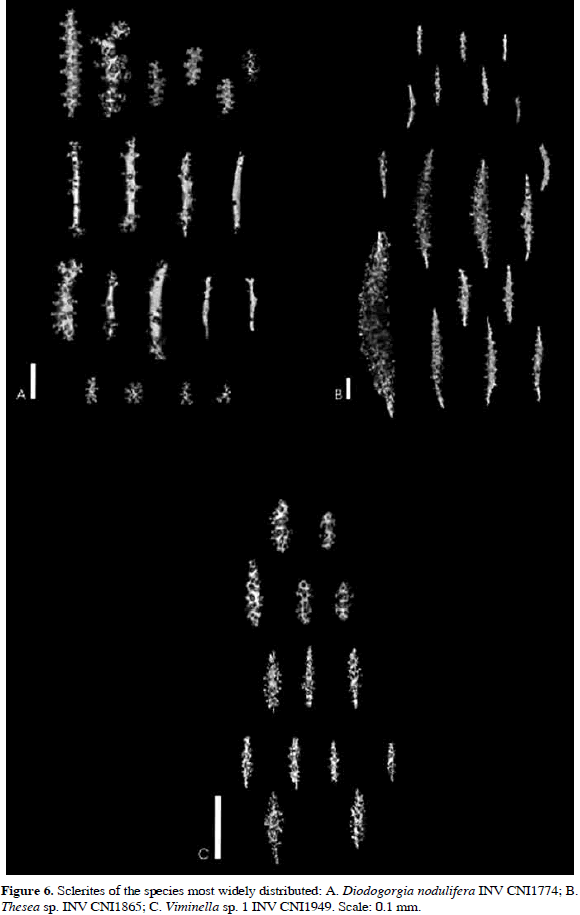Services on Demand
Journal
Article
Indicators
-
 Cited by SciELO
Cited by SciELO -
 Access statistics
Access statistics
Related links
-
 Cited by Google
Cited by Google -
 Similars in
SciELO
Similars in
SciELO -
 Similars in Google
Similars in Google
Share
Boletín de Investigaciones Marinas y Costeras - INVEMAR
Print version ISSN 0122-9761
Bol. Invest. Mar. Cost. vol.41 no.1 Santa Marta Jan./June 2012
DEEP-WATER OCTOCORALS (ANTHOZOA: CNIDARIA) COLLECTED FROM THE COLOMBIAN CARIBBEAN DURING 'MACROFAUNA EXPLORATIONS' 1998-2002*
OCTOCORALES (ANTHOZOA: CNIDARIA) RECOLECTADOS DURANTE LAS EXPLORACIONES MACROFAUNA (20-500 M DE PROFUNDIDAD) A LO LARGO DEL CARIBE COLOMBIANO
Isabel Cristina Chacón-Gómez1, Javier Reyes2 and Nadiezhda Santodomingo3
1 Universidad Nacional de Costa Rica. Heredia, San José, Costa Rica. icchacongomez@gmail.com.
2 Instituto de Investigaciones Marinas y Costeras-INVEMAR, Museo de Historia Natural Marina de Colombia, Grupo de investigación sobre Taxonomía, Sistemática y Ecología Marina. Cerro Punta de Betín, Santa Marta, Colombia. j_reyes_forero@hotmail.com.
3 Natural History Museum, Cromwell Road, SW7 5BD, London, United Kingdom. nadiasantodomingo@hotmail.com.
ABSTRACT
Octocorals are being included in a great variety of worldwide studies with the aim of analyzing taxonomy, ecology, biogeography, genetics and geochemistry, among other aspects. The study described here includes samples collected during the 'Macrofauna' explorations carried out by the Instituto de Investigaciones Marinas y Costeras-INVEMAR between 1998 and 2002 from shallow (20 m) to deep (500 m) waters. A total of 280 museum containers were examined. Samples were collected at 32 stations distributed along the continental shelf and upper slope of Colombian Caribbean. A total of 44 species have been recognized, 21 of them identified to species level and 23 to genus level; the species are included in 22 genera and nine families (Plexauridae, Gorgoniidae, Ellisellidae, Primnoidae, Anthothelidae, Clavulariidae, Keroeididae, Acanthogorgiidae, Chrysogorgiidae). Eight species and two genera are first records for Colombia.
KEY WORDS: Gorgonacea, Alcyonaria, Taxonomy, Colombia, Caribbean.
RESUMEN
Los octocorales están siendo incluidos en una variedad de estudios a nivel mundial, buscando el análisis de su taxonomía, ecología, biogeografía, genética, geoquímica, entre otros. El estudio que se describe a continuación incluye las muestras recolectadas durante las exploraciones llevadas a cabo por el Instituto de Investigaciones Marinas y Costeras-INVEMAR entre 1998 y 2002 desde aguas someras (20 m) hasta profundidades de 500 m. Se examinaron un total de 280 lotes de museo. Las muestras fueron recolectadas en 32 estaciones distribuidas a lo largo del talud y la plataforma continental del Caribe colombiano. Se reconocieron un total de 44 especies; 21 de ellas identificadas a nivel de especie y 23 a nivel de género; se encuentran distribuidas en 22 géneros y nueve familias (Plexauridae, Gorgoniidae, Ellisellidae, Primnoidae, Anthothelidae, Clavulariidae, Keroeididae, Acanthogorgiidae, Chrysogorgiidae). Ocho especies y dos géneros son primeros registros para Colombia.
PALABRAS CLAVES: Gorgonacea, Alcyonaria, Taxonomía, Colombia, Caribe.
INTRODUCTION
Octocorals, also known as alcyonarians, are distributed worldwide within a large depth range through the oceans. Thus, they are conspicuous anthozoans in a variety of sea environments and have been studied since the nineteenth century. Alcyonarians have a three-dimensional structure and provide shelter to other invertebrates and fishes (Sánchez et al., 1998; Witherell and Coon, 2001; Krieger and Wing, 2002). Additionally, their plasticity, allows them great morphological and physiological variety (Bayer, 1961; Grasshoff, 1976; Fabricius and Alderslade, 2001). Therefore, diagnostic characters are difficult to define and their taxonomy is incomplete (Bayer, 1961; Sánchez and Wirshing, 2005; Sánchez, 2007). Octocorals have not had comparable research to that of scleractinian corals, partly because of the difficulty in differentiating species (Sánchez and Wirshing, 2005). Thus, many studies are limited by the uncertainty of species identification. There are still some cases in which the identification to genus level is a valid option even in the most important collections (Stephen D. Cairns. Smithsonian National Museum of Natural History. Washington D.C.,U.S.A. 2005. Pers. Comm.), since trying to attain species level identification can be subjective or erroneous because of lack of taxonomic revisions and keys, which is given because the characters combinations can be ambiguous (Bayer, 1961; Sánchez and Wirshing, 2005).
Technological development has helped to enhance our knowledge of alcyonarians. Molecular techniques (Sánchez et al., 2003; McFadden et al., 2006) are currently being included in studies about cnidarians collected in deep waters, analyzing communities or populations, as another tool to comprehend the taxonomy and systematics of the group. Geochemistry is used to understand palaeoenvironments and climate change in octocoral axes (Allard et al., 2005; Bond et al., 2005; Spero et al., 2005), and there are also studies aiming to find some alternative applications of octocoral tissues as medical resources (Ehrlich et al., 2006). Nevertheless, it should be noted that a morphological approach is the starting point for taxonomic studies.
A great variety of approaches to this group are known, especially in regard to taxonomic issues (Grasshoff, 2001). Literature by Bayer (1961, 1981) describing his research on octocoral taxonomy has been used since the sixties and still remains one of the most comprehensive resources (De Victor and Morton, 2007). Deichmann (1936) and Bayer (1949, 1952, 1957, 1959) included complete morphological descriptions and detailed illustrations for Caribbean fauna in their publications. Besides these authors, some important revisions have been published about octocoral taxonomy in the Western Atlantic (Cairns, 2001; Cairns and Bayer, 2002). Other studies describing octocoral occurrences for different regions around the world have been carried out. Just to mention a few of them, some examples are Grasshoff (1999), Fabricius and Alderslade (2001) in the Pacific and Indian Oceans. The high octocoral diversity of the Red Sea was described in the works of Grasshoff (1976) and Benayahu (1985). There are also some collections from Southern Africa (Williams 1992a, 1992b, 2000), the eastern Northern Atlantic and Mediterranean Sea (Grasshoff, 1973).
Studies in the Caribbean were undertaken by Jordan-Dahlgren (1989) in Yucatán; Keith (1992) studied shallow water gorgonians in Honduras; Muzik (1981) and Lasker and Coffroth (1983) studied them in Belize. In South America, octocorals fauna is still poorly known as Marques and Castro (1995) indicated. There are a few examples of taxonomical studies carried out in South America, such as Medeiros and Castro (1996, 1999) who studied octocorals off Brazil, González-Brito (1970), Márquez et al. (1997) and Rada and Ruiz (2002) studied them in Venezuela. Sánchez and Wirshing (2005) provided a field key to the identification of tropical Western Atlantic zooxanthelate octocorals.
Colombia is one of the megabiodiverse countries (IUCN, 2011), and consequently it is ambitious to know all the species that occupy Colombian oceans. The most representative studies about taxonomy and ecology of Colombian octocorals have been attributed to Botero (1987), Sánchez (1994, 1998, 1999, 2001) and Sánchez et al. (1997) in shallow coral reefs, and Lattig-Matiz (2000) and Reyes et al. (2005) in deep waters. This paper presents a checklist of octocorals collected during the 'Macrofauna explorations' carried out by the Instituto de Investigaciones Marinas y Costeras-INVEMAR (Colombian Marine and Coastal Research Institute) between 1998 and 2002 along the Colombian Caribbean continental shelf and upper slope.
MATERIAL AND METHODS
Samples were collected by trawling at 32 sampling stations, distributed along the continental shelf and upper slope (20 to 500 m) off the Colombian Caribbean (Figure 1, Table 1). Trawls were carried out using a demersal trawling semiballoon net (Gracia, 2000; Rachello, 2003), varying by location, during the explorations performed by INVEMAR. All the samples were preserved in museum pots with 70 % ethanol solution. A total of 280 museum containers were examined. Each relevant structure of the samples was analyzed for identification with the aid of taxonomy keys and comparisons with descriptions found in the various references. Sclerite preparations for photographs were made as suggested by Bayer (1961) and the photographs were taken using a light microscope with a digital camera attached to it. The complete information has been systematized into the Marine Biodiversity Information System (INVEMAR 2009), a database in which each morphotype is described, with taxonomic notes about the identification, collection information, and detailed images of the samples and its structures. Identifications were mostly based on literature, but some species have been also confirmed comparing them to samples and type material deposited in the Smithsonian National Museum of Natural History, Washington.
RESULTS AND DISCUSSION
A total of 44 species have been recognized, included in 22 genera and nine families: Plexauridae, Gorgoniidae, Ellisellidae, Primnoidae, Anthothelidae, Clavulariidae, Keroeididae, Acanthogorgiidae, Chrysogorgiidae. It was possible to reach the species level for 21 of them, and the other were identified to genus level (Table 2).
The main taxonomic difficulties were due to limiting characters; for example, in family Ellisellidae, most of which are whip like colonies, and sclerite size variation is just a few micrometers, the majority of them have similar colors. Thus, two Viminella species were recognized and the principal differences were based on the polyp's arrangement along the axis. In the first one, the polyps are aligned on each side of the axis, being very close to each other, directly opposite to a polyp on the other side, and alternating between various sizes. In the other one, the polyps are also aligned on each side of the axis, but not so close together, not directly opposite to the polyp on the other side, and they only alternate between two main general sizes. In genus Verrucella, four species were distinguished by the colony sizes and pattern, and arrangement of polyps. The colonies of sp. 1, sp. 2 and sp. 4 are typically flabellate (fan-shaped), with their branches directed to all the sides, with only some dichotomous divisions; and those of sp. 3 has dichotomous branching all over the colony and the branches grow only in one direction. In the other hand, sp. 1, sp. 3 and sp. 4 have their polyps facing the anterior side of the colony, while sp. 2 has them laterally aligned on each side of the axis. Sp. 1 and sp. 4 have them in an opposite position to each other on the other side and the other two have them alternating between them and not so close to each other.
Also in the family Plexauridae there were some difficulties to identify the samples to species level, because they exhibit multiple modifications among genera that belong to this family and their diagnostic characters (Sánchez and Wirshing, 2005). For example, in the literature it is still not clear which diagnostic characters are used to reach the species level in the genus Thesea. Hence, the Colombian samples identified as Thesea exhibited most of the characters but they were not completely similar to those described in bibliography. For instance Thesea solitaria Pourtalés, 1868 presents the same whip-like colonies and sclerites, but instead of the original description (never branched), some Colombian specimens were branched. Thesea parviflora Deichmann, 1936 was common along the Colombian Caribbean and the specimens collected in this study were the most similar to the original description for the species in literature: colony shape (branching, whip-like, slender, scarce and flexible) texture, and calicular structure (shape and size) are also similar, but sclerites differ in size, distribution and color. The other species described for this genus (T. hebes, T. grandiflora, T. plana, and T. rugosa) are not morphologically similar to the samples collected in the study area. Additionally, in the collection of The National Museum of Natural History-Smithsonian Institution inWashington, DC there are several museum containers full of Thesea samples, identified also as Thesea sp. Viminella sp. is also such a case; this genus has many taxonomical problems and is still being discussed by researchers, as some other genera in the Ellisellidae family (Bayer and Grasshoff, 1994).
Eight species and two genera were new records for Colombia: Hypnogorgia pendula Duchassaing and Michelotti, 1864 (Figures 2; 3A), Acanthomuricea sp. (Figures 2; 3B), Scleracis guadaloupensis Duchassaing and Michelotti, 1860 (Figures 2, 3C), Placogorgia atlantica Wright and Studer, 1889 (Figures 2; 3D), Muricella sp. (Figures 2; 3E), Lophogorgia cardinalis (Figures 2; 3F), Lophogorgia punicea (Figures 2; 3G), Chrysogorgia thyrsiformis Deichmann, 1936 (Figures 2; 3H), Riisea paniculata (Figures 2, 3I) and Leptogorgia medusa Bayer, 1952 (Figures 2; 3J). There were also some specimens of Tobagogorgia hardyi Sánchez, 2007 (Figures 2; 3K) a species described recently (Chacón-Gómez et al., 2008). Most of the former species have already been reported for adjacent waters to the Colombian Caribbean, such as Venezuela (Rada and Ruiz, 2002), Brazil (Medeiros and Castro, 1999), and also other Caribbean regions (Bayer, 1961; Bayer and Grasshoff, 1994; Cairns, 2001). Thus, the geographic ranges of these species were extended to Colombia, suggesting that information gaps about the distribution of species are still imminent and should be clarified as soon as possible, by means of exhaustive surveys including deep waters. Muricella and Acanthomuricea are genera known before from Pacific waters. Although these genera display many uncertain identifications (Fabricius and Alderslade, 2001), the Caribbean specimens were identified as belonging to them, according to literature (Grasshoff, 1999; Fabricius and Alderslade, 2001) and were confirmed by comparisons with collection specimens. Other evidence concerning the presence of Pacific species in Colombian Caribbean waters has been found around this area, for example, the solitary coral Tethocyathus prahli (Lattig and Cairns, 2000), known as fossil in the Pacific Panama coast; the fish Quadratus ancon (Mok et al., 2001), genus distributed in the Western Pacific, and the ophiuroid Ophiosizygus disacanthus (Borrero-Pérez and Benavides-Serrato, 2004), previously described from Japan.
Most species (about 80 %) were aggregated in the northeastern Colombian Caribbean, which includes three eco-physiographical regions: La Guajira (GUA), Palomino (PAL) and Tayrona (TAY) (Figure 1). These results agree with other outcomes from Macrofauna surveys, which suggest that the northeastern region (GUA-PAL-TAY) is characterized by a high biodiversity (Lattig and Reyes, 2001; Navas and Campos, 2001; Saavedra et al., 2004; Reyes et al., 2005). According to Jiménez-Valverde and Hortal (2003), species accumulation curves could be very useful to compare octocoral diversity in specific areas, but if the area sampled (seafloor topography, general conditions) and the processes to collect are dissimilar at each sampling point or station because of those differences, one would not expect an accurate outcome. Because the features of the sampling areas were remarkably different to each other, it was not always possible to get equal or comparable samples. Therefore, the only accurate data that could be quantitatively analyzed would be the richness of species in terms of number of species at each sampling station to demonstrate that the Northeastern region actually presents a higher biodiversity than other areas at the Colombian Caribbean (Figure 4). But it is clear that a sampling process with comparable collections or samplings should be developed to be able to test that fact. Even though, this high species richness can be assumed because it seems to be linked to local environmental features (Díaz and Gómez, 2000), such as geomorphology of the continental shelf which may or may not provide suitable substrate for attachment, and the upwelling effect, which increases the nutrient availability and, in consequence, there are suitable conditions to the occurrence of suspension feeders such as octocorals.
A remarkable richness of species was found in the sampling stations Dibulla (PAL: E 102, 13 species) and La Aguja (TAY: E 80, 13 species) (Table 1), which could be related to the development of azooxanthellate coral communities. The three-dimensional configuration built by the scleractinians Cladocora debilis Milne Edwards and Haime, 1849, Madracis myriaster (Milne-Edwards and Haime, 1849) and Anomocora fecunda (De Pourtalès, 1871), and octocorals provides shelter for a high diversity of invertebrates and fishes at these localities (Reyes et al., 2005). Moreover, it appears that the presence of octocorals contributes to enhanced diversity of other invertebrates, since mollusks, ophiuroids, crustaceans, foraminifera, hydroids, bryozoans, and polychaetes were found attached to the colonies. Thus, the important role of octocorals in tropical deep sea marine communities requires an ecosystem perspective.
The results of this study indicate that the most common species in the Colombian continental shelf were Diodogorgia nodulifera Hargitt, 1901 (Figures 5A and 6A), Trichogorgia lyra Bayer and Muzik, 1976 (Figure 5B) Thesea sp. (Figures 5B and 6B) and Viminella sp. (Figures 5D, 6C), since they were found and collected in almost all the regions, becoming the most abundant and most widespread (Figure 1), and they were found up to 200 m depth. In deeper waters, the most common species collected was Chrysogorgia elegans Verrill, 1883 (Family Chrysogorgiidae). It was also recurrent to find species in shallower water that were already reported, such as Carijoa riisei Duchassaing and Michelotti, 1860 and Acanthogorgia aspera Pourtales, 1867. Thesea parviflora Deichmann, 1936 and Leptogorgia setacea (Pallas), 1766, which appeared only in three regions: Guajira (GUA); Tayrona (TAY) and Palomino (PAL), where they occur frequently up to 200 m depth.
In the Colombian Caribbean, a preliminary list (unpublished data, J. A. Sánchez) includes about 90 shallow water octocoral species belonging to 25 genera, mostly plexaurids and gorgoniids. In the present study, five genera are recorded for the first time (Muricella, Acanthomuricea, Hypnogorgia, Scleracis, Riisea) therefore a total of 30 genera are now known for the Colombian Caribbean waters. According to Bayer (1961), around 40 genera are known for the West Indian region (exclusive of Pennatulacea and Alcyonacea), suggesting that 75 % of genera in the Caribbean region inhabit Colombian waters. This study increases the knowledge about octocorals in Colombian Caribbean and has brought to light some of the species living in deep waters. However, further research about taxonomy and systematics, which includes scanning electron microscope and molecular techniques, should be undertaken in order to identify specimens at species level and to describe the wide phenotypic variation of this group.
ACKNOWLEDGMENTS
This research is one of the results of the project Macrofauna INVEMARCOLCIENCIAS No. 2015-09-16649. We thank The National Museum of Natural History- Smithsonian Institute, for the donation of some confirmation specimens; especially to Dr. S. Cairns, who also taught us skills to make better sclerite slides and provided us with bibliography and advises. P. Lattig helped us with identification. Thanks to F. M. Bayer for his advises for identification of material. Drs. A. Acero P., John R. Turner, and James M. Mair gave some guidance related to the manuscript.
LITERATURE CITED
1 Allard, G., D. J. Sinclair, B. Williams, C. Hillaire-Marcel, S. Ross and M. Risk. 2005. Dendrochronology in bamboo? Geochemical profiles and reproducibility in a specimen of the deep-water bamboo coral, Keratoisis spp. 204-204. In: George, R. Y. y S. Cairns (Eds.). Program and abstract book. 3rd International Symposium on Deep-Sea Corals, Sciences and Management. Rosentiel School of Marine Sciences, Miami. 252 p. [ Links ]
2 Bayer, F. M. 1949. The Alcyonaria of Bikini and other atolls in the Marshall group. Part I: The Gorgonacea. Pac. Sci., 3 (3): 195-210. [ Links ]
3 Bayer, F. M. 1952. Descriptions and redescriptions of the Hawaiian octocorals collected by the U. S. Fish Comission Steamer "Albatross". (1. Alcyonacea, Stolonifera and Telesacea). Pac. Sci., 6 (2): 126-136. [ Links ]
4 Bayer, F. M. 1957. Additional records of western Atlantic octocorals. J. Wash. Acad. Sci., 47 (11): 379-390. [ Links ]
5 Bayer, F. M. 1959. Octocorals from Surinam and the adjacent coasts of South America. Studies on the fauna of Suriname and other Guayanas, 6: 1-43. [ Links ]
6 Bayer, F. M. 1961. The shallow water Octocorallia of the West Indian region. A manual for marine biologists. Martinus Nijhoff, The Hague, Netherlands. 373 p. [ Links ]
7 Bayer, F. M. 1981. Key to the genera of Octocorallia exclusive of Pennatulacea (Coelenterata: Anthozoa), with diagnoses of new taxa. Proc. Biol. Soc. Wash., 94 (3): 902-947. [ Links ]
8 Bayer, F. M. 1991. Thelogorgia a new genus of gorgonacean octocorals, with descriptions of four new species from the western Atlantic. Bull. Mar. Sci., 49 (1-2): 506-537. [ Links ]
9 Bayer, F. M. and M. Grasshoff. 1994. The genus group taxa of the family Ellisellidae, with clarification of the genera established by J. E. Gray (Cnidaria: Octocorallia). Senckenb. Biol., 74 (1-2): 21-45. [ Links ]
10 Bayer, F. M. and K. M. Muzik. 1976. New genera and species of the holaxonian family Chrysogorgiidae (Octocorallia: Gorgonacea). Zool. Meded., 50 (5): 65-90. [ Links ]
11 Benayahu, Y. 1985. Faunistic composition and patterns in the distribution of soft corals (Octocorallia: Alcyonacea) along the coral reefs of Sinai Peninsula. Proc. 5th Int. Coral Reef Congress, Tahiti, 6: 255-260. [ Links ]
12 Bond, Z. A., A. L. Cohen, S. R. Smith and W. J. Jenkins. 2005. Growth and composition of high-Mg calcite in the skeleton of a Bermudian gorgonian (Plexaurella dichotoma): Potential for paleothermometry, Geochem. Geophys. Geosyst., 6, Q08010, doi:10. 1029/2005GC000911. [ Links ]
13 Borrero-Pérez, G. H. and M. Benavides-Serrato. 2004. New records of Ophiosizygus disacanthus Clark, 1911 (Echinodermata: Ophiuroidea: Ophiomyxidae) in the Caribbean Sea. Proc. Biol. Soc. Wash., 117 (4): 541-544. [ Links ]
14 Botero, L. 1987. Zonación de octocorales gorgonáceos en el área de Santa Marta y Parque Nacional Natural Tayrona, costa Caribe colombiana. An. Inst. Invest. Mar. Punta de Betín, 17: 61-80. [ Links ]
15 Cairns, S. D. 2001. Studies on western Atlantic Octocorallia (Coelenterata: Anthozoa) Part 1: The genus Chrysogorgia Duchassaing and Michelotti, 1864. Proc. Biol. Soc. Wash., 114 (3): 746-787. [ Links ]
16 Cairns, S. D. and F. M. Bayer. 2002. Studies on western Atlantic Octocorallia (Coelenterata: Anthozoa). Part 2: The genus Callogorgia Gray, 1858. Proc. Biol. Soc. Wash., 115 (4): 840-867. [ Links ]
17 Chacón-Gómez, I. C., N. Santodomingo and J. Reyes. 2008. First record of Tobagogorgia hardyi (Octocorallia: Gorgonidae) from the Colombian Caribbean. Bol. Invest. Mar. Cost., 37 (1): 211-216. [ Links ]
18 Deichmann, E. 1936. The Alcyonaria of the western part of the Atlantic Ocean. Mem. Mus. Comp. Zool. Harvard Coll., Vol. LIII, Cambridge. 317 p. [ Links ]
19 De Victor, S. T. and S. L. Morton. 2007. Guide to the shallow water (0-200 m) octocorals of the South Atlantic Bight. S. T. http://www. dnr. sc. gov/marine/sertc/octocoral%20guide/octocoral. htm. 01/07/2009. [ Links ]
20 Díaz, J. M. and D. I. Gómez (Eds.). 2000. Programa nacional de investigación en biodiversidad marina y costera (PNIBM). INVEMAR, FONADE y MMA, Santa Marta. 80 p. [ Links ]
21 Ehrlich, H., P. Etnoyer, S. D. Litvinov, M. Olennikova, H. Domaschke, T. Hanke, R. Born, H. Meissner and H. Worch. 2006. Biomaterial structure in deep-sea bamboo coral (Gorgonacea: Isididae): perspectives for the development of bone implants. Materialwissenschaft und Werkstofftechnik, 37 (6): 553-557. [ Links ]
22 Fabricius, K. and P. Alderslade. 2001. Soft corals and sea fans. A comprehensive guide to the tropical shallow-water genera of the Central-West Pacific, the Indian Ocean and the Red Sea. Australian Institute of Marine Science, Melbourne: New Litho, Australia. 264 p. [ Links ]
23 Goldberg, W. M. 2001. The sclerites and geographic distribution of the gorgonian Swiftia exserta (Coelenterata: Octocorallia: Holaxonia). Proc. Biol. Soc. Wash., 10: 100-109. [ Links ]
24 Gónzález-Brito, P. 1970. Algunos octocorales de la isla de Margarita, Venezuela. Bol. Inst. Oceanogr. Univ. Oriente, 9 (1-2): 79-92. [ Links ]
25 Gracia, A. 2000. Taxocenosis de los moluscos epibentónicos de la franja superior del talud continental (300 y 500 m) entre Punta Gloria y Cabo Tiburón, Caribe colombiano. Undergraduate thesis, Univ. Bogotá Jorge Tadeo Lozano, Bogotá. 382 p. [ Links ]
26 Grasshoff, M. 1973. Die Gorgonaria des oestlichen Nordatlantik und des Mittelmeeres. II. Die Gattung Acanthogorgia (Cnidaria: Anthozoa). Auswertung der "Atlantischen Kuppenfahrten 1967" von F. S. "Meteor". "Meteor" Forsch-Ergebnisse. Reihe D, (13): 1-10. [ Links ]
27 Grasshoff, M. 1976. Gorgonariaaus den Riffen von Eilat, Rotes Meer (Cnidaria: Anthozoa). Senckenb. Biol., 57 (1-3): 155-165. [ Links ]
28 Grasshoff, M. 1988. The genus Leptogorgia (Octocorallia: Gorgoniidae) in West Africa. "Meteor Forschungsergibnisse". Herausgegeben von der Deutschen Forschungsgemeinschaft D, (28): 91-147. [ Links ]
29 Grasshoff, M. 1999. The shallow water gorgonians of New Caledonia and adjacent islands. Senckenb. Biol., 78 (1-2): 1-121. [ Links ]
30 Grasshoff, M. 2001. Taxonomy, systematics, and Octocorals: to Frederick M. Bayer. Proc. Biol. Soc. Wash., 10: 3-14. [ Links ]
31 INVEMAR. 2009. SIBM: Sistema de Información sobre Biodiversidad Marina. Instituto de Investigaciones Marinas y Costeras. http://siam. invemar. org. co/siam/sibm/index. htm. 15/11/2009. [ Links ]
32 IUCN. 2011. IUCN at work in South America - a land of diversity and contrast. http://www. iucn. org/knowledge/news/focus/amazonia_to_patagonia/. 15/12/2010. [ Links ]
33 Jiménez-Valverde, A. and J. Hortal. 2003. Las curvas de acumulación de especies y la necesidad de evaluar la calidad de los inventarios biológicos. Rev. Ibér. Aracnol., 8 (31): 151-161. [ Links ]
34 Jordan-Dahlgren, E. 1989. Gorgonian community structure and reef zonation patterns on Yucatan coral reefs. Bull. Mar. Sci., 45 (3): 678-696. [ Links ]
35 Keith, D. E. 1992. Shallow-water gorgonians (Octocorallia) of Roatan, Honduras. Bull. Mar. Sci., 50 (1): 212-226. [ Links ]
36 Krieger, K. J. and B. L. Wing. 2002. Megafauna associations with deepwater corals (Primnoa spp.) in the Gulf of Alaska. Hydrobiologia, 471 (1-3): 83-90. [ Links ]
37 Lasker, H. R. and M. A. Coffroth. 1983. Octocoral distributions at Carrie Bow Cay, Belize. Mar. Ecol. Prog. Ser., 13: 21-28. [ Links ]
38 Lattig-Matiz, P. 2000. Porifera, Cnidaria y Annelida de la franja superior del talud continental (200-500 m) del Caribe colombiano. Undergraduate thesis, Pontificia Universidad Javeriana, Bogotá. 191 p. [ Links ]
39 Lattig, P. and S. D. Cairns. 2000. A new species of Tethocyathus (Scleractinia: Caryophylliidae), a Trans-Isthmian azooxanthellate species. Proc. Biol. Soc. Wash., 113 (3): 590-595. [ Links ]
40 Lattig, P. and J. Reyes. 2001. Nueve primeros registros de corales azooxanthelados (Anthozoa: Scleractinia) del Caribe colombiano (200 m-500 m). Bol. Inv. Mar. Cost., 30: 19-38. [ Links ]
41 Marques, A. C. S. J. and C. B. Castro. 1995. Muricea (Cnidaria: Octocorallia) from Brazil with description of a new species. Bull. Mar. Sci., 56 (1): 161-172. [ Links ]
42 Márquez, L. M., F. J. Losada and M. Rodríguez. 1997. Zonation and structure of a gorgonian community in Venezuela. Proc. 8th Internat. Coral Reef Symp., 1: 447-450. [ Links ]
43 McFadden, C. S., S. C. France, J. A. Sánchez and P. Alderslade. 2006. A molecular phylogenetic analysis of the Octocorallia (Coelenterata: Anthozoa) based on mitochondrial protein-coding sequences (ND2, msh1). Mol. Phylog. . Evol., 41 (3): 513-527. [ Links ]
44 Medeiros, M. S. and C. B. Castro. 1996. A new record of octocoral (Cnidaria) from Brazil. Bol. Mus. Nac., (366): 1-8. [ Links ]
45 Medeiros, M. S. and C. B. Castro. 1999. Paramuriceidae e Plexauridae (Cnidaria, Octocorallia) do Brasil: batimetria e distribuicao geográfica. Bol. Mus. Nac., (398): 1-20. [ Links ]
46 Mok, H., L. M. Saavedra-Díaz and A. Acero. 2001. Two new species of Eptatretus and Quadratus (Myxinidae, Myxiniformes) from the Caribbean coast of Colombia. Copeia, 4: 1026-1033. [ Links ]
47 Muzik, K. 1981. Octocorallia (Cnidaria) from Carrie Bow Cay, Belize. Smithson. Contrib. Mar. Sci., (12): 303-310. [ Links ]
48 Navas, G. R. and N. H. Campos. 2001. Crustáceos estomatópodos colectados por los cruceros INVEMAR Macrofauna, incluyendo dos nuevos registros para el mar Caribe colombiano. Bol. Inv. Mar. Cos., 30: 67-76. [ Links ]
49 Rachello, P. 2003. Inventario y caracterización estructural de los moluscos de la plataforma continental del Caribe colombiano (20, 70 y 150 m). Undergraduate thesis. Pontificia Univ. Javeriana, Bogotá. 145 p. [ Links ]
50 Rada, M. and L. Ruiz. 2002. Octocorales de la Isla de Blanquilla, Dependencias Federales, Venezuela. Mem. Soc. Cienc. Nat. La Salle, 157: 31-52. [ Links ]
51 Reyes, J., N. Santodomingo, A. Gracia, G. Borrero-Pérez, G. Navas, L. M. Mejía-Ladino, A. Bermúdez and M. Benavides. 2005. Southern Caribbean azooxanthellate coral communities off Colombia. 309-330. In: Freiwald, A. and J. M. Roberts (Eds.). Cold-water corals and ecosystems. Springer-Verlag, Berlin. 1279 p. [ Links ]
52 Saavedra-Díaz, L. M., A. Roa-Varón, A. Acero P. and L. M. Mejía. 2004. Nuevos registros ícticos en el talud superior del Caribe colombiano (órdenes Albuliformes, Anguilliformes, Osmeriformes, Stomiiformes, Ateleopodiformes, Aulopiformes y Pleuronectiformes). Bol. Inv. Mar. Cos., 33: 181-207. [ Links ]
53 Sánchez, J. A. 1994. Presencia de los Octocorales Stylatula diadema Bayer (Pennatulacea) y Carijoa riisei (Duchassaing y Michelotti) /Telestacea) en la costa Caribe colombiana. An. Inst. Invest. Mar. Punta de Betín, 23: 137-147. [ Links ]
54 Sánchez, J. A. 1998. Sistemática filogenética del género Eunicea Lamoroux, 1816 (Octocorallia: Gorgonacea: Plexauridae) con aspectos sobre la historia natural de algunas especies en el Caribe colombiano. Master's degree thesis. Univ. Nacional de Colombia, Bogotá. 134 p. [ Links ]
55 Sánchez, J. A. 1999. Black coral-octocoral distribution patterns on Imelda Bank, a deep-water reef, Colombia, Caribbean Sea. Bull. Mar. Sci., 65 (1): 215-225. [ Links ]
56 Sánchez, J. A. 2001. Systematics of the southwestern Caribbean Muriceopsis Aurivillius (Cnidaria: Octocorallia), with the description of a new species. Proc. Biol. Soc. Wash., 10: 160-180. [ Links ]
57 Sánchez, J. A. 2007. A new genus of Atlantic octocorals (Octocorallia: Gorgoniidae): Systematics of gorgoniids with asymmetric sclerites. J. Nat. Hist., 41 (9): 493-509. [ Links ]
58 Sánchez, J. A. and H. H. Wirshing. 2005. A Field Key to the identification of tropical Western Atlantic zooxanthellate octocorals (Octocorallia: Cnidaria). Caribb. J. Sci., 41 (3): 508-522. [ Links ]
59 Sánchez, J. A., J. M. Díaz. and S. Zea. 1997. Gorgonian communities in two contrasting environments on oceanic atolls of the southwestern Caribbean. Bull. Mar. Sci., 61 (2): 453-465. [ Links ]
60 Sánchez, J. A., S. Zea and J. M. Díaz. 1998. Patterns of octocoral and black coral distribution in the oceanic barrier reef-complex of Providencia Island, Southwestern Caribbean. Caribb. J. Sci., 34 (3-4): 250-264. [ Links ]
61 Sánchez, J. A., H. R. Lasker and D. J. Taylor. 2003. Phylogenetic analyses among octocorals (Cnidaria) according to mitochondrial and nuclear DNA sequences (lsu-rRNA 16S, and ssu-rRNA 18S) support two convergent clades of branching gorgonians. Mol. Phylog. Evol., 29 (1): 31-42. [ Links ]
62 Spero, H. J., D. Clague and J. Barry. 2005. Environmental variability at intermediate water depths recorded by bamboo coral Geochemistry. 189-189. In: George, R. Y. and S. Cairns (Eds.). Program and abstract book. 3rd International Symposium on Deep-Sea Corals, Sciences and Management. Rosentiel School of Marine Sciences, Miami. 252 p. [ Links ]
63 Williams, G. C. 1992a. The Alcyonacea of Southern Africa. Stoloniferous octocorals and soft corals. (Coelenterata, Anthozoa). Ann. S. Afr. Mus., 100 (3): 249-358. [ Links ]
64 Williams, G. C. 1992b. The Alcyonacea of Southern Africa. Gorgonian octocorals (Coelenterata, Anthozoa). Ann. S. Afr. Mus., 101 (8): 181-293. [ Links ]
65 Williams, G. C. 2000. Two new genera of soft corals (Anthozoa: Alcyoniidae) from South Africa, with a discussion of diversity and endemism in the Southern African octocorallian fauna. Proc. Calif. Acad. Sci., 52 (6): 65-75. [ Links ]
66 Witherell, D. and C. Coon. 2001. Protecting gorgonian corals off Alaska from fishing impacts. Report to NPFMC. 117-125. In: Willison, J. H., M. J. Hall, S. E. Gass, E. L. R. Kenchington, M. Butler and P. Doherty (Eds.). Proceedings of the First International Symposium on Deep-Sea Corals. Ecology Action Centre, Nova Scotia Museum, Halifax. 231 p. [ Links ]
FECHA DE RECEPCIÓN: 23/03/2010 FECHA DE ACEPTACIÓN: 13/04/2012
*Contribución No. 1104 del Instituto de Investigaciones Marinas y Costeras-INVEMAR.













